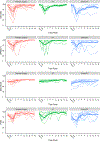Upfront Neck Dissection for Treatment Selection and Improvement in Quality of Life as a Novel Treatment Paradigm for Deintensification in HPV+ OPSCC
- PMID: 38517480
- PMCID: PMC11147695
- DOI: 10.1158/1078-0432.CCR-23-3247
Upfront Neck Dissection for Treatment Selection and Improvement in Quality of Life as a Novel Treatment Paradigm for Deintensification in HPV+ OPSCC
Abstract
Purpose: Locoregionally advanced HPV+ oropharyngeal squamous cell carcinoma (OPSCC) has excellent cure rates, although current treatment regimens are accompanied by acute and long-term toxicities. We designed a phase II deescalation trial for patients with HPV+ OPSCC to evaluate the feasibility of an upfront neck dissection to individualize definitive treatment selection to improve the quality of life without compromising survival.
Patients and methods: Patients with T1-3, N0-2 HPV+ OPSCC underwent an upfront neck dissection with primary tumor biopsy. Arm A included patients with a single lymph node less than six centimeters, with no extracapsular spread (ECS) and no primary site adverse features underwent transoral surgery. Arm B included patients who had two or more positive lymph nodes with no ECS, or those with primary site adverse features were treated with radiation alone. Arm C included patients who had ECS in any lymph node and were treated with chemoradiation. The primary endpoint was quality of life at 1 year compared with a matched historical control.
Results: Thirty-four patients were enrolled and underwent selective neck dissection. On the basis of pathologic characteristics, 14 patients were assigned to arm A, 10 patients to arm B, and 9 to arm C. A significant improvement was observed in Head and Neck Quality of Life (HNQOL) compared with historical controls (-2.6 vs. -11.9, P = 0.034). With a median follow-up of 37 months, the 3-year overall survival was 100% and estimated 3-year estimated progression-free survival was 96% [95% confidence interval (CI), 76%-99%].
Conclusions: A neck dissection-driven treatment paradigm warrants further research as a deintensification strategy.
©2024 American Association for Cancer Research.
Conflict of interest statement
Figures
References
Publication types
MeSH terms
Grants and funding
LinkOut - more resources
Full Text Sources
Medical




